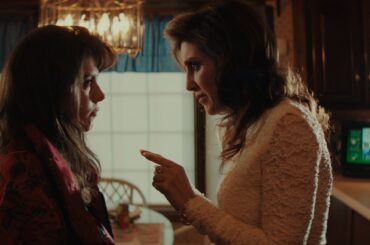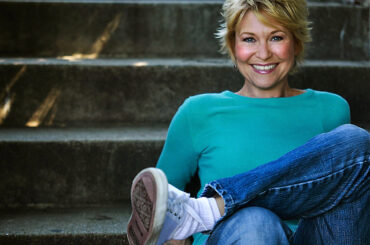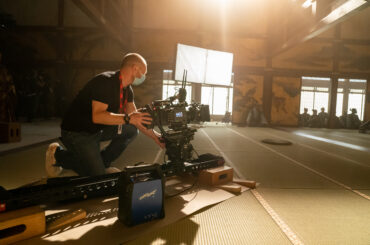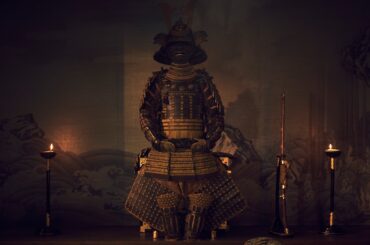Música, to put it quite simply, is an utter delight. Composer, director, star, and writer Rudy Mancuso crafted a romantic musical that talks about creativity and his experience with synesthesia, where his brain turns everyday sounds into rhythm. It’s a lot of visual information, which editor Melissa Kent crafts with an absolute sense of clarity and cleanliness.
The editor behindThe Dirt and The Virgin Suicides, not to mention co-editor of The Rainmaker, makes an overwhelming sensory overload experience not only accessible but foot-tapping, romantic entertainment. Given Kent’s background in studying theater and performing music, Música made prime use of her many skills as an artist.
Recently, Kent spoke with Immersive about her work on Música, including crafting musical numbers and defining a singular point-of-view.
[Note: This interview has been edited for clarity and length]
How did you want to set the tone with the opening diner scene? What rules did you want to establish?
All openings are vital because you’re setting up the world, the tone, the characters and the plot. It went through a lot of variation. Haley is trying to get Rudy’s attention, but he is perceiving musical notes more than her words. And then we cut into the diner with some very quick cuts of “música,” our term for Rudy’s rhythmic synesthesia.
First, I had to make this conversation work, be interesting and set the pace of this movie. And it’s highly unusual to have a breakup scene be the first scene. Meanwhile, the reason behind their conflict is because he’s so easily distracted. I think we really found the balance of slowly but surely introducing more and more moments of cutaways, of rhythm, of items that distract Rudy, be they a broom, someone pouring iced tea, putting down salt and pepper shakers, hitting the cash register’s keys, until it is out of his control.
The music overtakes Haley’s voice, and we expand into this incredible dance and rhythm number. Choreographer Marivaldo Dos Santos was in Stomp on Broadway for many years and brought a lot of those dancers with him for these scenes. As fun as it is, we also had to be sure not to overwhelm the audience right from the jump. And so, yeah, there was a lot of back and forth and asking opinions and getting reactions. Wow, what a dynamic way to open a movie.
Yeah, it’s funny that it’s a breakup scene, because it’s also a feel-good scene at the same time.
Well, he’s meant to break up with her, right? This is as it should be.
When you’re cutting two people falling in love, what are the subtlest moments or qualities as an editor that you want to emphasize in two performances?
Falling in love, it’s all about chemistry. I need to be sensitive to what the actors are bringing, especially the way they make eye contact. Now, in the case of Música, the very first scene that was shot is Camilla Mendes, playing Isabella, and Rudy Mancuso sitting in a park where he explains the phenomenon of synesthesia and how everyday sounds—like sports in the park, people running by, traffic—turn into a rhythm in his mind.
It’s about how he experiences the world and how his brain works. He himself says sometimes it feels like torture and sometimes it’s nice, but as he’s opening himself up and he’s playing a character based on himself, Camilla Mendes is getting to know Rudy not just as a character but as a person. And as you might have seen on Instagram, they ended up falling in love. They got together right after they finished shooting the movie, so that chemistry was real.
In the rare case where actors might not like each other so much, then you need to start hiding things and creating looks and moments that maybe weren’t organic. But in the case of Rudy and Isabella, all I needed to do was build the scene based on the way they were connecting.
The way he sees the world, you show how overwhelming it is, and yet, you make it accessible and not confounding. How was that balance in editing?
Even when we’re in the world of “música,” I treated it as reality. Because for Rudy, it is. And our journey as an audience corresponds to his. In a way, by turning sounds into musical rhythms, Rudy is in fact making the chaos of the world more organized and more predictable. Then we just had fun with the edits to increase or decrease energy and vitality as needed.
Did you also think, thank God they recorded this live so I can cut just right to the pace and rhythm?
Although Rudy had written these rhythmic numbers ahead of time, the actual sounds were recorded on set, captured by up to 100 microphones, strategically hidden by executive music producer Jamie Rise.
I worked with a stereo track and once the picture was locked, Jamie replaced that with the pristine sound from all those individual microphones that sounded beautiful. To prepare for the final mix, rather than creating music pre-dubs where 100 tracks might be reduced to between 8–30, the choice was made to provide all the individual tracks to sound re-recording mixer Christopher S. Aud so that he had maximum flexibility. Whatever is seen onscreen, he was able to feature that sound, even if it is on for less than half a second, so that the experience totally came alive.
There’s a wonderful walk and talk in the movie where Rudy tries being in the moment with Isabella but he’s thinking how he thinks. How was it cutting a walk with that much happening in a scene?
Rudy and Isabella in the Ironbound was a unique walk and talk. All the camera coverage was in 2-shot, either in front or from behind. Rudy perceives the world as though music completely surrounds him, and in this particular case, it had maybe gone a little too far. Originally, there were people in the street playing instruments or doing rhythms while he’s getting to know Isabella. For someone who doesn’t have synesthesia, it was a little too much. It was a little too distracting for the audience, because this is them just getting to know each other. It’s their first main conversation. So as an audience, I want to be all-in on that.
How’d you experiment to get that just right then?
We kept experimenting with how much of the street life to hear. Eventually Rudy, wearing his “composer” hat, provided a rhythmic percussive sound that underscored the entire conversation. It provided the same feeling as people performing live, but we had a lot more control of volume.
Then as they enter the fair, the Ironbound feira, his synesthesia is becoming a bit stronger. As you see, people are tapping on watermelons, as people pour drinks it’s in rhythm, and the guy at the grill cooks in rhythm. It’s progressing, but I feel like we still managed to hear their conversation.
We really had to hit hard [in that conversation] the fact that he loves working with puppets in the subway, because that pays off at the end of the movie. Isabella asks him, “Are you going to take it higher?” Again, because they didn’t have time to shoot coverage, I only had from the front and from the back, so anything that was important, I would blow up the frame a little, make it a little bigger, so that it would land a little better.
And because Isabella is highlighting for Rudy the unique beauty of their neighborhood and culture, he eventually gives in to the synesthesia as the world explodes with music and dance and vibrancy.
Let’s talk about screwball comedies. There’s the scene where Rudy is basically on two dates at once. How long does that scene go?
It landed at about six-and-a-half minutes.
How’d you make a six-and-a-half-minute scene play fast?
That’s rather long for a movie scene. I was looking at the script yesterday out of curiosity, because it is a 15-page scene, and obviously we’re not going to stay in this restaurant for 15 minutes. Ordinarily when you read a script, it’s an average of one minute of movie per page. So yeah, it does become a bit screwball, doesn’t it?
The scene takes place in Brasilia Grill, which is in Newark, New Jersey. Most of these locations are where the real-life thing happened, including this moment where Rudy is with his ex-girlfriend and then runs into his new girlfriend. In the scene, he bounces back and forth, as you said, in a screwball sort of way. (IRL, he’s not proud of having done this).
Now, what’s more complicated besides the fact we’re in a Brazilian restaurant where some characters are speaking Portuguese, is that we have a live piano player, and he was playing live on this day. Of course, during dialogue scenes, his keyboard was muted, but I nonetheless got the recording feed of what he played.
Did you start with letting the dialogue or music lead that scene?
First and foremost, I edited the dialogue scenes, so they are snappy. The main challenge was the music underlying it. As you saw, eventually we’ve got the piano player, Marcio (Etienne Stadwijk), giving Rudy the side-eye. He sees what he’s doing with both women, but then they start communicating solely via music with subtitles. And of course, anytime I cut to Marcio, the music we hear has to match what his hands are doing. And that’s where my own history of playing piano is very helpful.
On a basic level, if he’s playing some high notes, I don’t want to see his hands all the way to the left. They’ve got to be in the right place on the keyboard. And then, rhythmically, if you hear a note is down and you see the fingers are up, even if it’s off by just a frame or two, that’s weird. In addition, as they have their so-called musical conversation, I have to get in and out of that in a musical way as well.
So, the trick is that with every dialogue change, the music must always stay musical, while keeping his hands looking as they should, and getting in and out of every little musical comment in a musical way while keeping all the dialogue going.
So, that was a lot.
I was wondering about the long take in this movie, was that shot organically? Was that stitched together? I couldn’t tell.
I’m so glad you brought up the oner. For an editor, you would think, oh, she could just put her feet up for half a day. It didn’t work like that. Here’s what happened….
Instead of a typical montage of Rudy spending his days dating two women and not always being truthful with his mother, Rudy’s concept was to have it all take place on a soundstage, with sets flying in and out, as he walks from one to the next, changing his shirt for each scene, all in one take.
They had a day of rehearsal to block the action of all the actors and the extras, plus the camera blocking and the sound. Then a day of shooting. The last take was the winner where everything, they nailed it. But because there was a little bit of coverage, I felt as an editor it was my responsibility to experiment with combining a bunch of takes. What if we utilize the coverage to go from take 15 to take 12 and then take 8 so that for each line, I could sort of pick my so-called “best” or “favorite?” I tried several combinations of takes. I tried speeding things up while he was walking. Rudy wanted no part of that.
Hey, sometimes we try things in order to verify that the original concept is the way to go. So, in the end, it is a true single shot: no visual effects, no fancy stitching takes together.
Did you have conversations with him about, like, getting the flow of the one take correct? What will work or won’t work with a long take?
Rudy stuck to his original concept, and I am glad he did. That’s the beauty of Rudy, because this is about his life and literally goes inside his brain. And so, he has a well-earned confidence for how this movie should unfold. I applaud that, because too often filmmakers or studios, especially studios, want to appeal to the widest common denominator. In doing so, things can become diluted and interesting to no one.
Here we have Rudy who couldn’t be more unique, creating a story about his own life. It’s an extremely strong point of view, showing us a way of seeing the world we’ve never experienced before. And people love watching it. I’ve never had such amazing reviews for a movie, and we got 95% [on Rotten Tomatoes]. This goes to show, be unique and individual.
Check back soon for part two of our interview with editor Melissa Kent.





